Susceptibility Mapping of Thaw Slumps Based on Neural Network Methods along the Qinghai–Tibet Engineering Corridor
Abstract
:1. Introduction
2. Materials and Methods
2.1. Study Area and Data Sources
2.2. Methods
2.2.1. Automated Identification of Thaw Slumping
2.2.2. Construction of Susceptibility Analysis Index System
2.2.3. RBF-Based Susceptibility Assessment Method
3. Results
3.1. Deep Learning Identification
3.2. Training Results of the RBF Model
3.3. The Impact of Controlling Factors
3.4. Thaw Slumping Susceptibility Mapping
4. Discussion
4.1. Comparison with Existing Studies
4.2. Advantages and Limitations of Thaw Slumping Identification Based on Neural Networks
4.3. Influencing Factors of Thaw Slump
4.4. Applications of the Susceptibility Map
5. Conclusions
Author Contributions
Funding
Institutional Review Board Statement
Informed Consent Statement
Data Availability Statement
Conflicts of Interest
References
- Anisimov, O.A.; Nelson, F.E. Permafrost distribution in the Northern Hemisphere under scenarios of climatic change. Glob. Planet. Chang. 1996, 14, 59–72. [Google Scholar] [CrossRef]
- Zhou, Y.; Guo, D.; Qiu, G.; Cheng, G.; Li, S. Geocryology in China. Permafr. Periglac. Process. 2000, 12, 315–322. [Google Scholar]
- Chen, J.; Wu, Y.; O’Connor, M.; Cardenas, M.B.; Schaefer, K.; Michaelides, R.; Kling, G. Active layer freeze-thaw and water storage dynamics in permafrost environments inferred from InSAR. Remote Sens. Environ. 2020, 248, 112007. [Google Scholar] [CrossRef]
- Liu, S.; Zhao, L.; Wang, L.; Zhou, H.; Zou, D.; Sun, Z.; Xie, C.; Qiao, Y. Intra-Annual Ground Surface Deformation Detected by Site Observation, Simulation and InSAR Monitoring in Permafrost Site of Xidatan, Qinghai-Tibet Plateau. Geophys. Res. Lett. 2022, 49, e2021GL095029. [Google Scholar] [CrossRef]
- Liu, L.; Schaefer, K.; Zhang, T.; Wahr, J. Estimating 1992–2000 average active layer thickness on the Alaskan North Slope from remotely sensed surface subsidence. J. Geophys. Res. Earth Surf. 2012, 117. [Google Scholar] [CrossRef]
- Nan, Z.; Li, S.; Cheng, G. Prediction of permafrost distribution on the Qinghai-Tibet Plateau in the next 50 and 100 years. Sci. China Ser. D Earth Sci. 2005, 48, 797–804. [Google Scholar] [CrossRef]
- Zhao, L.; Wu, Q.; Marchenko, S.S.; Sharkhuu, N. Thermal state of permafrost and active layer in Central Asia during the International Polar Year. Permafr. Periglac. Process. 2010, 21, 198–207. [Google Scholar] [CrossRef]
- Koven, C.D.; Ringeval, B.; Friedlingstein, P.; Ciais, P.; Cadule, P.; Khvorostyanov, D.; Krinner, G.; Tarnocai, C. Permafrost carbon-climate feedbacks accelerate global warming. Proc. Natl. Acad. Sci. USA 2011, 108, 14769–14774. [Google Scholar] [CrossRef] [PubMed]
- Zhang, Z.; Wang, M.; Wu, Z.; Liu, X. Permafrost deformation monitoring along the Qinghai-Tibet Plateau engineering corridor using InSAR observations with multi-sensor SAR datasets from 1997–2018. Sensors 2019, 19, 5306. [Google Scholar] [CrossRef]
- Howard, H.R.; Manandhar, S.; Wang, Q.; Mcmillan, J.M.; Qie, G.; Liu, X.; Thapa, K.; Xu, X.; Wang, G. Spatially characterizing land surface deformation and permafrost active layer thickness for Donnelly installation of Alaska using DInSAR and MODIS data. Cold Reg. Sci. Technol. 2022, 196, 103510. [Google Scholar] [CrossRef]
- Aas, K.S.; Martin, L.; Nitzbon, J.; Langer, M.; Boike, J.; Lee, H.; Berntsen, T.K.; Westermann, S. Thaw processes in ice-rich permafrost landscapes represented with laterally coupled tiles in a land surface model. Cryosphere 2019, 13, 591–609. [Google Scholar] [CrossRef]
- Zhang, M.; Wang, B.; Wang, D.; Ye, W.; Guo, Z.; Gao, Q.; Yue, G. The effects of rainfall on the surface radiation of permafrost regions in Qinghai-Tibet Plateau: A case study in Beiluhe area. J. Glaciol. Geocryol 2021, 43, 1092–1101. [Google Scholar]
- Zhang, X.; Zhang, H.; Wang, C.; Tang, Y.; Zhang, B.; Wu, F.; Wang, J.; Zhang, Z. Time-series InSAR monitoring of permafrost freeze-thaw seasonal displacement over Qinghai–Tibetan Plateau using Sentinel-1 data. Remote Sens. 2019, 11, 1000. [Google Scholar] [CrossRef]
- Grosse, G.; Harden, J.; Turetsky, M.; McGuire, A.D.; Camill, P.; Tarnocai, C.; Frolking, S.; Schuur, E.A.G.; Jorgenson, T.; Marchenko, S.; et al. Vulnerability of high-latitude soil organic carbon in North America to disturbance. J. Geophys. Res. Biogeosciences 2011, 116. [Google Scholar] [CrossRef]
- Lantuit, H.; Pollard, W.H.; Couture, N.; Fritz, M.; Schirrmeister, L.; Meyer, H.; Hubberten, H.W. Modern and late Holocene retrogressive thaw slump activity on the Yukon coastal plain and Herschel Island, Yukon Territory, Canada. Permafr. Periglac. Process. 2012, 23, 39–51. [Google Scholar] [CrossRef]
- Li, Y.; Jin, H.; Wen, Z.; Wen, Z.; Zhao, Z.; Jin, X. Stability of permafrost slopes: A review. J. Glaciol. Geocryol. 2022, 44, 203–216. [Google Scholar]
- Ni, J.; Wu, T.; Zhu, X.; Hu, G.; Zou, D.; Wu, X.; Li, R.; Xie, C.; Qiao, Y.; Pang, Q.; et al. Simulation of the present and future projection of permafrost on the Qinghai-Tibet Plateau with statistical and machine learning models. J. Geophys. Res. Atmos. 2021, 126, e2020JD033402. [Google Scholar] [CrossRef]
- Ramage, J.L.; Irrgang, A.M.; Herzschuh, U.; Morgenstern, A.; Couture, N.; Lantuit, H. Terrain controls on the occurrence of coastal retrogressive thaw slumps along the Yukon Coast, Canada. J. Geophys. Res. Earth Surf. 2017, 122, 1619–1634. [Google Scholar] [CrossRef]
- Lantuit, H.; Pollard, W.H. Fifty years of coastal erosion and retrogressive thaw slump activity on Herschel Island, southern Beaufort Sea, Yukon Territory, Canada. Geomorphology 2008, 95, 84–102. [Google Scholar] [CrossRef]
- Jones, M.K.W.; Pollard, W.H.; Jones, B.M. Rapid initialization of retrogressive thaw slumps in the Canadian high Arctic and their response to climate and terrain factors. Environ. Res. Lett. 2019, 14, 055006. [Google Scholar] [CrossRef]
- Linlin, L.; Liming, J.; Zhiwei, Z.; Yuxing, C.; Yafei, S. Object-oriented classification of unmanned aerial vehicle image for thermal erosion gully boundary extraction. Remote Sens. Land Resour. 2019, 31, 180–186. [Google Scholar]
- Witharana, C.; Udawalpola, M.R.; Liljedahl, A.K.; Jones, M.K.W.; Jones, B.M.; Hasan, A.; Joshi, D.; Manos, E. Automated detection of retrogressive thaw slumps in the high Arctic using high-resolution satellite imagery. Remote Sens. 2022, 14, 4132. [Google Scholar] [CrossRef]
- Abolt, C.J.; Young, M.H. High-resolution mapping of spatial heterogeneity in ice wedge polygon geomorphology near Prudhoe Bay, Alaska. Sci. Data 2020, 7, 87. [Google Scholar] [CrossRef] [PubMed]
- Nitze, I.; Heidler, K.; Barth, S.; Grosse, G. Developing and testing a deep learning approach for mapping retrogressive thaw slumps. Remote Sens. 2021, 13, 4294. [Google Scholar] [CrossRef]
- Yang, Y.; Rogers, B.M.; Fiske, G.; Watts, J.; Potter, S.; Windholz, T.; Mullen, A.; Nitze, I.; Natali, S.M. Mapping retrogressive thaw slumps using deep neural networks. Remote Sens. Environ. 2023, 288, 113495. [Google Scholar] [CrossRef]
- Kaur, H.; Gupta, S.; Parkash, S.; Thapa, R. Knowledge-driven method: A tool for landslide susceptibility zonation (LSZ). Geol. Ecol. Landsc. 2023, 7, 1–15. [Google Scholar] [CrossRef]
- Yin, G.; Luo, J.; Niu, F.; Liu, M.; Gao, Z.; Dong, T.; Ni, W. High-resolution assessment of retrogressive thaw slump susceptibility in the Qinghai-Tibet Engineering Corridor. Res. Cold Arid. Reg. 2023, 15, 288–294. [Google Scholar] [CrossRef]
- Rudy, A.C.; Lamoureux, S.F.; Treitz, P.; Van Ewijk, K.Y. Transferability of regional permafrost disturbance susceptibility modelling using generalized linear and generalized additive models. Geomorphology 2016, 264, 95–108. [Google Scholar] [CrossRef]
- Yin, G.; Luo, J.; Niu, F.; Lin, Z.; Liu, M. Machine learning-based thermokarst landslide susceptibility modeling across the permafrost region on the Qinghai-Tibet Plateau. Landslides 2021, 18, 2639–2649. [Google Scholar] [CrossRef]
- Jiang, Y.; Yang, K.; Qi, Y.; Zhou, X.; He, J.; Lu, H.; Li, X.; Chen, Y.; Li, X.; Zhou, B.; et al. TPHiPr: A long-term (1979–2020) high-accuracy precipitation dataset (1/30°, daily) for the Third Pole region based on high-resolution atmospheric modeling and dense observations. Earth Syst. Sci. Data 2023, 15, 621–638. [Google Scholar] [CrossRef]
- Niu, F.; Yin, G.; Luo, J.; Lin, Z.; Liu, M. Permafrost distribution along the Qinghai-Tibet Engineering Corridor, China using high-resolution statistical mapping and modeling integrated with remote sensing and GIS. Remote Sens. 2018, 10, 215. [Google Scholar] [CrossRef]
- Marmanis, D.; Datcu, M.; Esch, T.; Stilla, U. Deep learning earth observation classification using ImageNet pretrained networks. IEEE Geosci. Remote Sens. Lett. 2015, 13, 105–109. [Google Scholar] [CrossRef]
- Eigen, D.; Fergus, R. Predicting depth, surface normals and semantic labels with a common multi-scale convolutional architecture. In Proceedings of the IEEE International Conference on Computer Vision, Santiago, Chile, 7–13 December 2015; pp. 2650–2658. [Google Scholar]
- Sun, C.; Zhao, H.; Mu, L.; Xu, F.; Lu, L. Image semantic segmentation for autonomous driving based on improved U-Net. Cmes-Comput. Model. Eng. Sci. 2023, 136, 787–801. [Google Scholar] [CrossRef]
- Yu, B.; Lane, I. Multi-task deep learning for image understanding. In Proceedings of the 2014 6th International Conference of Soft Computing and Pattern Recognition (SoCPaR), Tunis, Tunisia, 11–14 August 2014; pp. 37–42. [Google Scholar]
- Li, X.; Liu, Z.; Luo, P.; Change Loy, C.; Tang, X. Not all pixels are equal: Difficulty-aware semantic segmentation via deep layer cascade. In Proceedings of the IEEE Conference on Computer Vision and Pattern Recognition, Honolulu, HI, USA, 21–26 July 2017; pp. 3193–3202. [Google Scholar]
- Jiang, X.; Jiang, J.; Yu, J.; Wang, J.; Wang, B. MSK-UNET: A Modified U-Net Architecture Based on Selective Kernel with Multi-Scale Input for Pavement Crack Detection. J. Circuits Syst. Comput. 2023, 32, 2350006. [Google Scholar] [CrossRef]
- Alexandridis, A.; Chondrodima, E.; Sarimveis, H. Radial basis function network training using a nonsymmetric partition of the input space and particle swarm optimization. IEEE Trans. Neural Netw. Learn. Syst. 2012, 24, 219–230. [Google Scholar] [CrossRef] [PubMed]
- Zhang, P.; Zhou, X.; Pelliccione, P.; Leung, H. RBF-MLMR: A multi-label metamorphic relation prediction approach using RBF neural network. IEEE Access 2017, 5, 21791–21805. [Google Scholar] [CrossRef]
- Liu, K.; Zhang, R.; Cui, Z.B.; Zhang, D.; Gao, S. Research on cloud model optimization radial basis function neural network algorithm. J. Henan Univ. Sci. Technol. (Nat. Sci.) 2023, 44, 49–55. [Google Scholar]
- Chen, S. Orthogonal Least Sequares Learning Algorithm for Radial Basis Function Networks. IEEE Trans. Neural Netw. 1991, 4, 246–257. [Google Scholar]
- Sun, Z.; Zhang, S. A radial basis function approximation method for conservative Allen–Cahn equations on surfaces. Appl. Math. Lett. 2023, 143, 108634. [Google Scholar] [CrossRef]
- Liu, M.; Peng, W.; Hou, M.; Tian, Z. Radial basis function neural network with extreme learning machine algorithm for solving ordinary differential equations. Soft Comput. 2023, 27, 3955–3964. [Google Scholar] [CrossRef]
- Niu, F.; Luo, J.; Lin, Z.; Fang, J.; Liu, M. Thaw-induced slope failures and stability analyses in permafrost regions of the Qinghai-Tibet Plateau, China. Landslides 2016, 13, 55–65. [Google Scholar] [CrossRef]
- Luo, J.; Niu, F.; Lin, Z.; Liu, M.; Yin, G. Recent acceleration of thaw slumping in permafrost terrain of Qinghai-Tibet Plateau: An example from the Beiluhe Region. Geomorphology 2019, 341, 79–85. [Google Scholar] [CrossRef]
- Huang, L.; Lantz, T.C.; Fraser, R.H.; Tiampo, K.F.; Willis, M.J.; Schaefer, K. Accuracy, efficiency, and transferability of a deep learning model for mapping retrogressive thaw slumps across the Canadian Arctic. Remote Sens. 2022, 14, 2747. [Google Scholar] [CrossRef]
- Karjalainen, O.; Luoto, M.; Aalto, J.; Hjort, J. New insights into the environmental factors controlling the ground thermal regime across the Northern Hemisphere: A comparison between permafrost and non-permafrost areas. Cryosphere 2019, 13, 693–707. [Google Scholar] [CrossRef]
- Xia, Z.; Huang, L.; Fan, C.; Jia, S.; Lin, Z.; Liu, L.; Luo, J.; Niu, F.; Zhang, T. Retrogressive thaw slumps along the Qinghai-Tibet Engineering Corridor: A comprehensive inventory and their distribution characteristics. Earth Syst. Sci. Data Discuss. 2022, 14, 3875–3887. [Google Scholar] [CrossRef]
- Karjalainen, O.; Luoto, M.; Aalto, J.; Etzelmüller, B.; Grosse, G.; Jones, B.M.; Lilleøren, K.S.; Hjort, J. High potential for loss of permafrost landforms in a changing climate. Environ. Res. Lett. 2020, 15, 104065. [Google Scholar] [CrossRef]
- Wang, R.; Guo, L.; Yang, Y.; Zheng, H.; Liu, L.; Jia, H.; Diao, B.; Liu, J. Thermokarst Lake Susceptibility Assessment Induced by Permafrost Degradation in the Qinghai–Tibet Plateau Using Machine Learning Methods. Remote Sens. 2023, 15, 3331. [Google Scholar] [CrossRef]
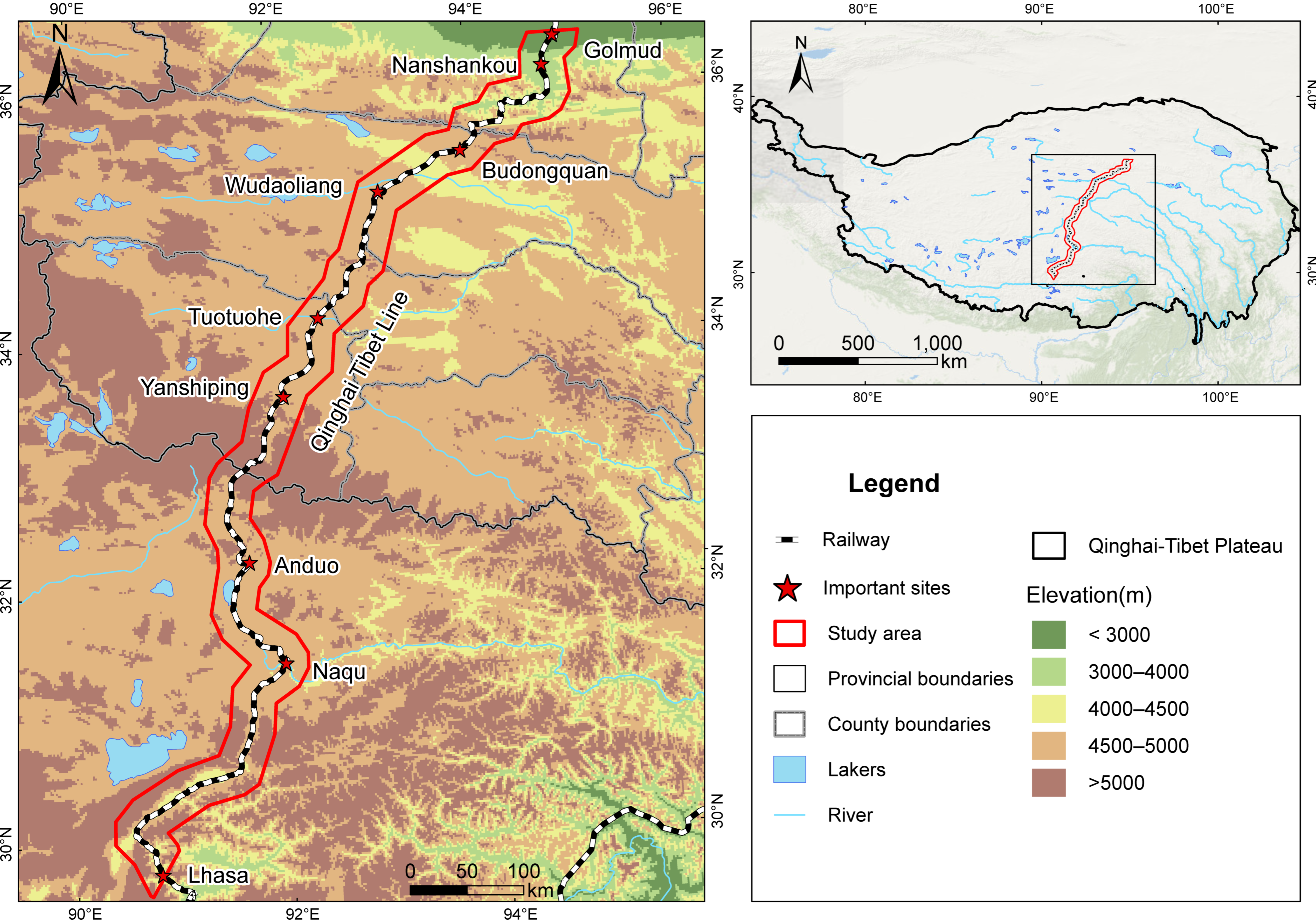
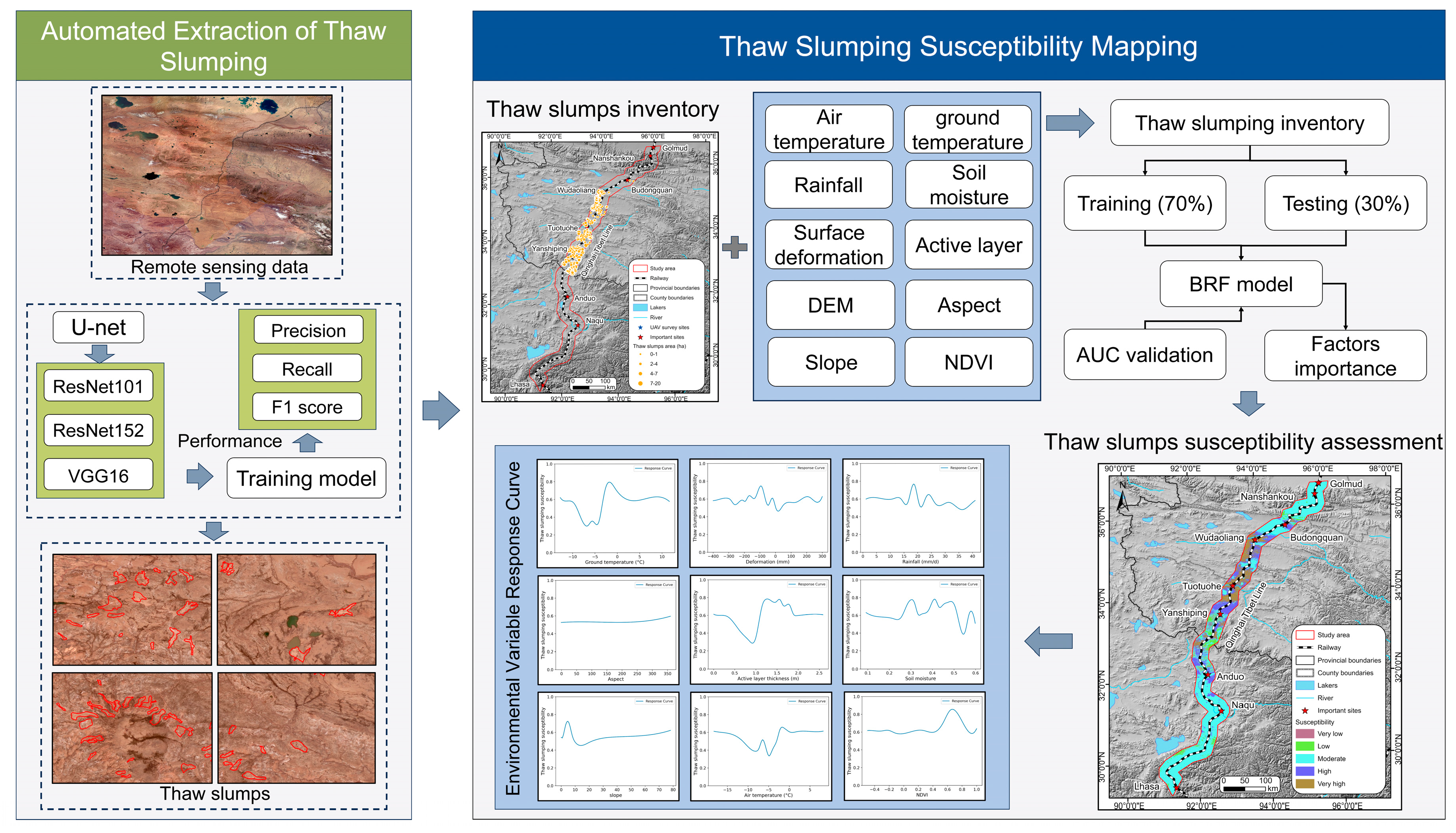
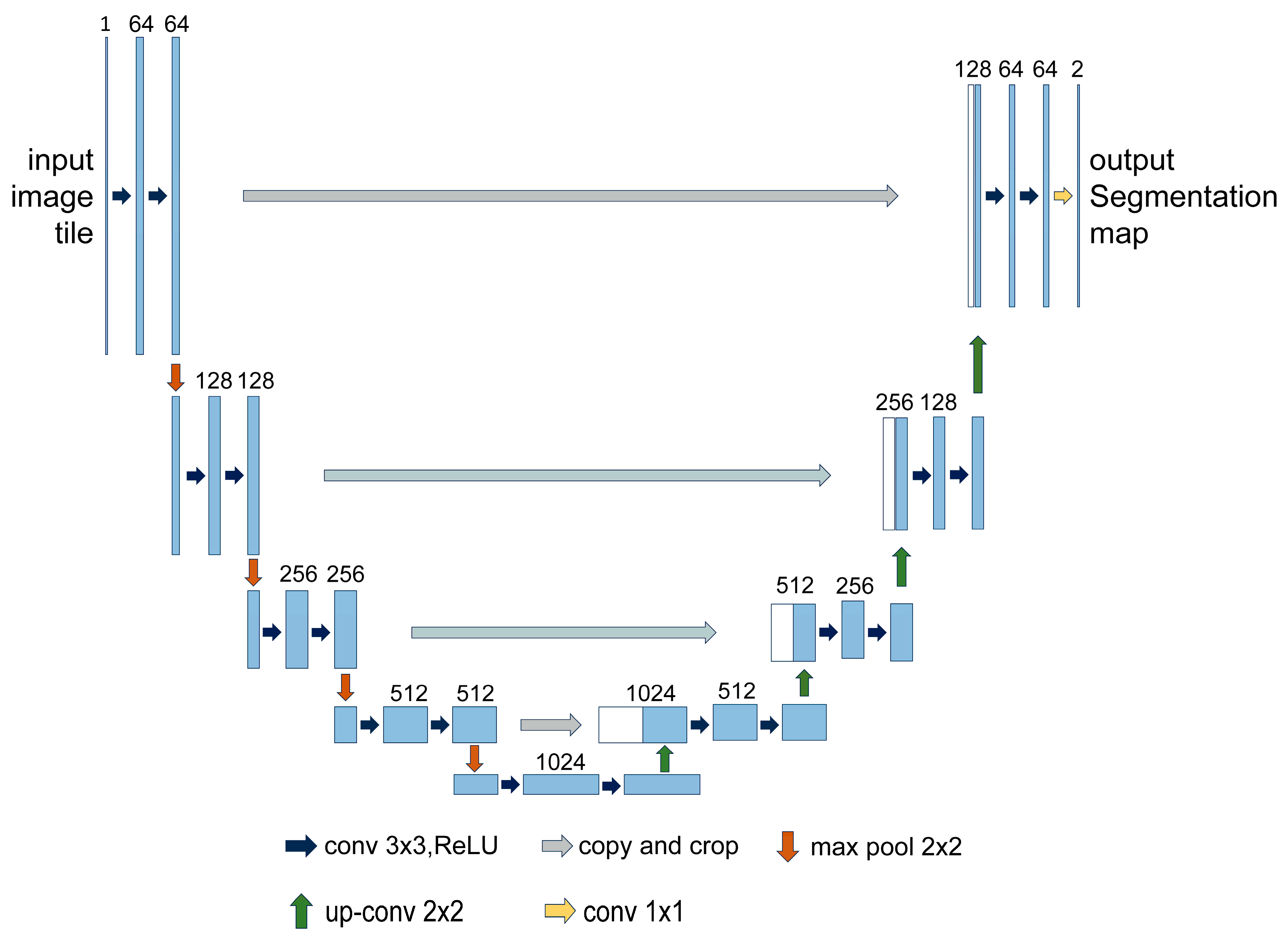



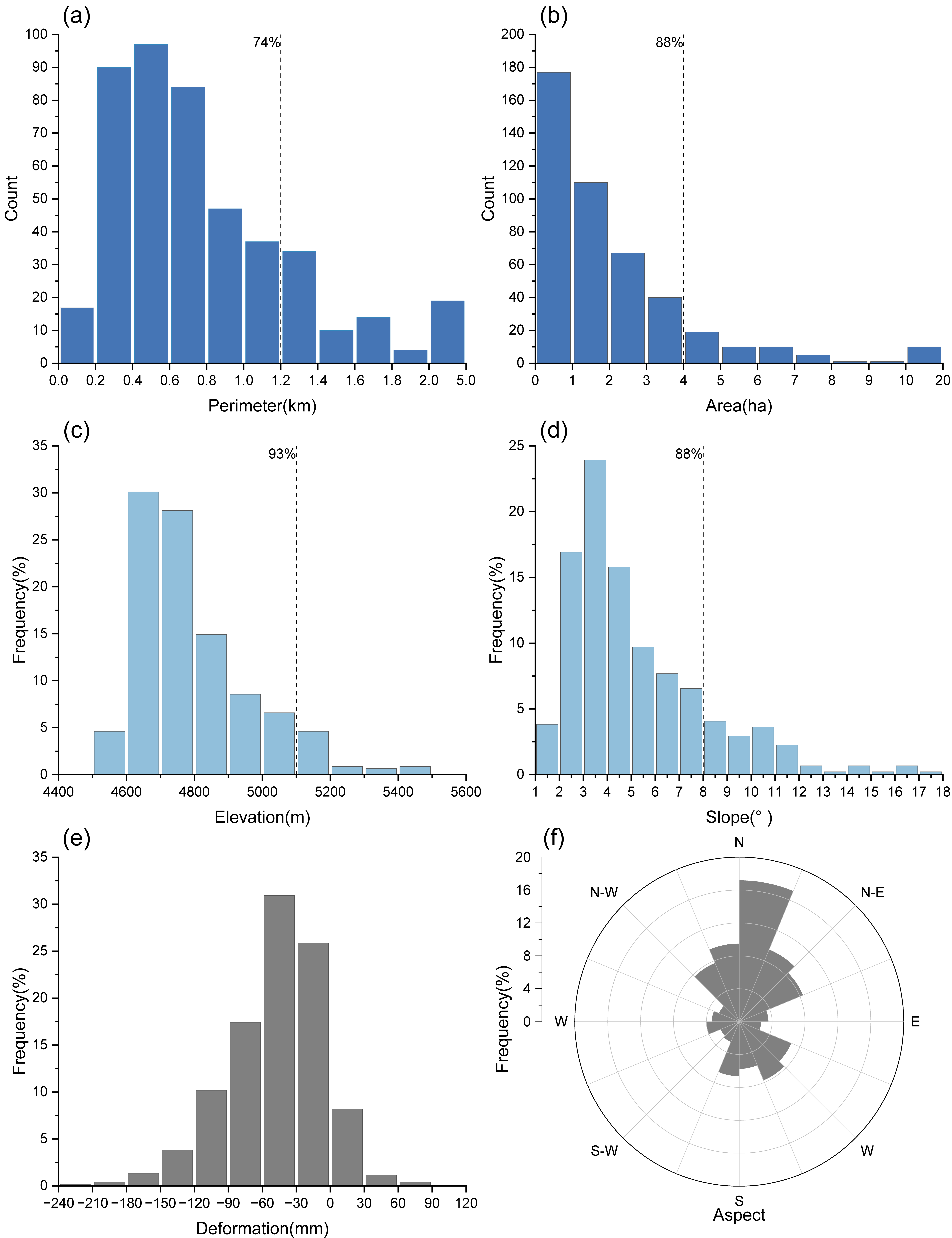
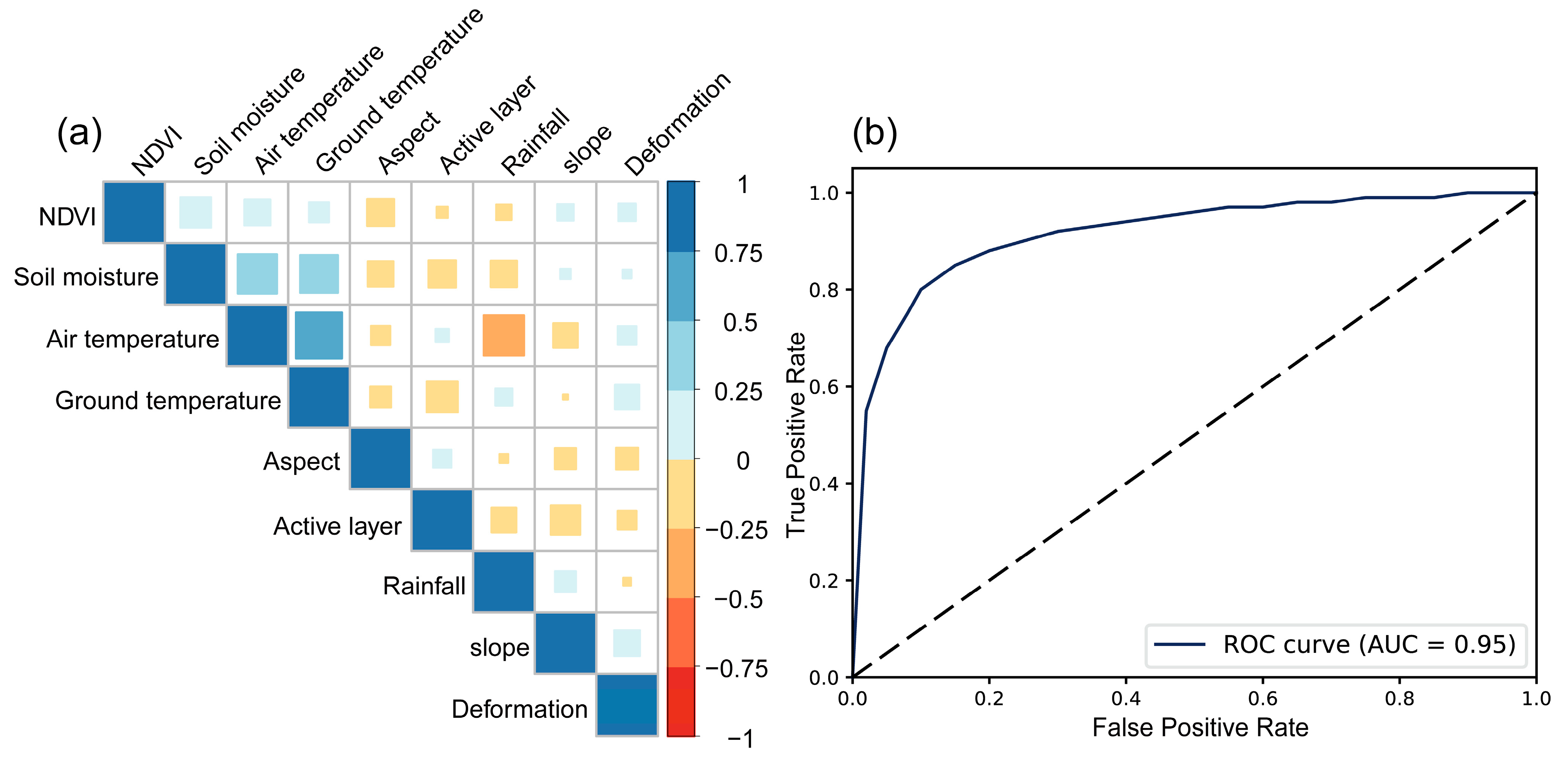


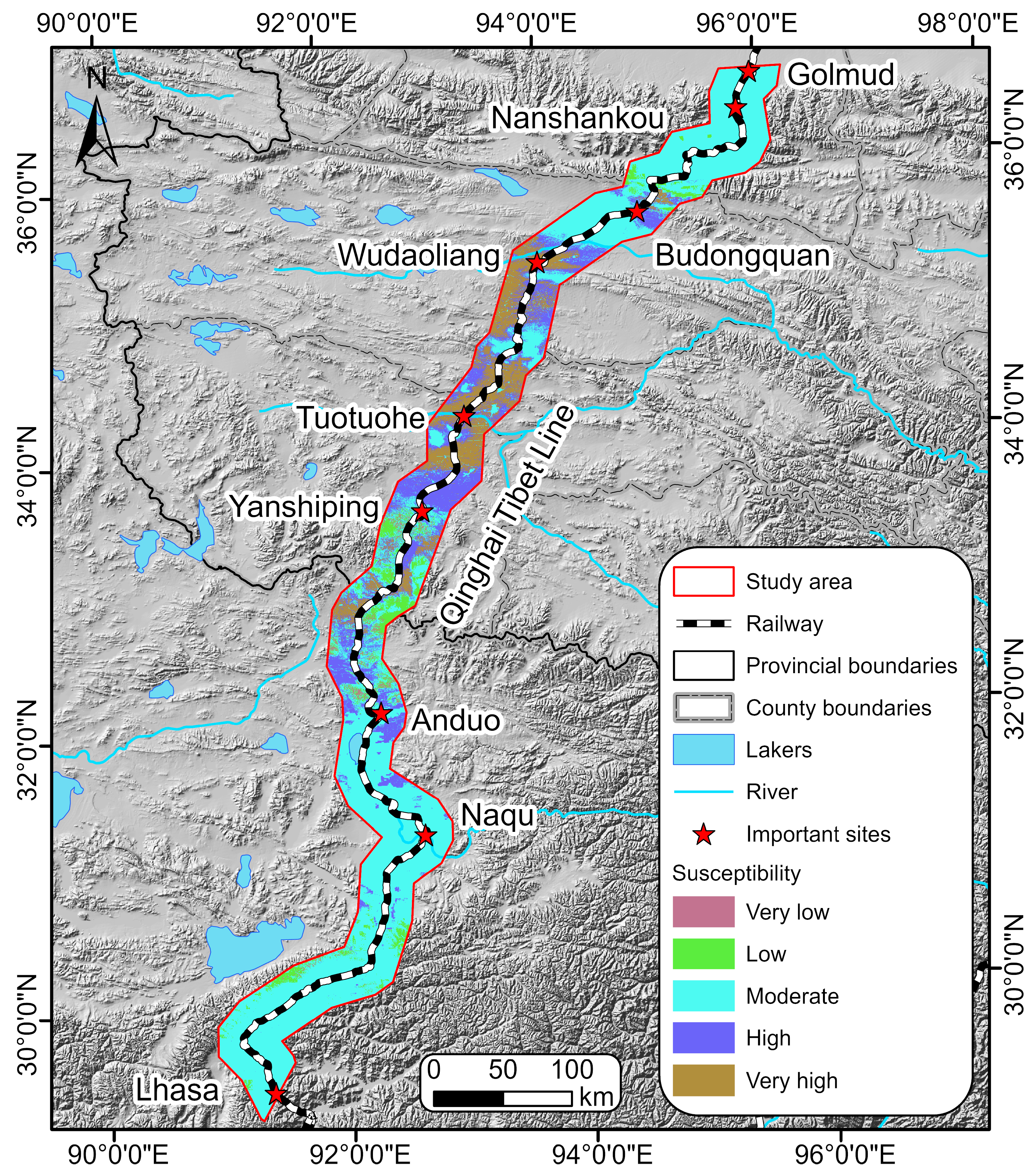
| Model Type | ResNet101 | ResNet152 | VGG16 |
|---|---|---|---|
| Precision | 0.864 | 0.787 | 0.793 |
| Recall | 0.847 | 0.386 | 0.337 |
| F1 score | 0.856 | 0.518 | 0.473 |
| Zone | Area (km2) | Proportion | Thaw Slumping Area (km2) | Proportion |
|---|---|---|---|---|
| Very low susceptibility | 293.11 | 0.71% | 0.04 | 0.29% |
| Low susceptibility | 2014.2 | 4.85% | 0.44 | 3.18% |
| Moderate susceptibility | 26,419.85 | 63.69% | 1.90 | 13.78% |
| High susceptibility | 7700.73 | 18.56% | 3.34 | 24.26% |
| Very high susceptibility | 5054.11 | 12.19% | 8.04 | 58.49% |
Disclaimer/Publisher’s Note: The statements, opinions and data contained in all publications are solely those of the individual author(s) and contributor(s) and not of MDPI and/or the editor(s). MDPI and/or the editor(s) disclaim responsibility for any injury to people or property resulting from any ideas, methods, instructions or products referred to in the content. |
© 2024 by the authors. Licensee MDPI, Basel, Switzerland. This article is an open access article distributed under the terms and conditions of the Creative Commons Attribution (CC BY) license (https://creativecommons.org/licenses/by/4.0/).
Share and Cite
Li, P.; Dong, T.; Wang, Y.; Luo, J.; Wang, H.; Zhang, H. Susceptibility Mapping of Thaw Slumps Based on Neural Network Methods along the Qinghai–Tibet Engineering Corridor. Sustainability 2024, 16, 5120. https://doi.org/10.3390/su16125120
Li P, Dong T, Wang Y, Luo J, Wang H, Zhang H. Susceptibility Mapping of Thaw Slumps Based on Neural Network Methods along the Qinghai–Tibet Engineering Corridor. Sustainability. 2024; 16(12):5120. https://doi.org/10.3390/su16125120
Chicago/Turabian StyleLi, Pengfei, Tianchun Dong, Yanhe Wang, Jing Luo, Huini Wang, and Huarui Zhang. 2024. "Susceptibility Mapping of Thaw Slumps Based on Neural Network Methods along the Qinghai–Tibet Engineering Corridor" Sustainability 16, no. 12: 5120. https://doi.org/10.3390/su16125120





